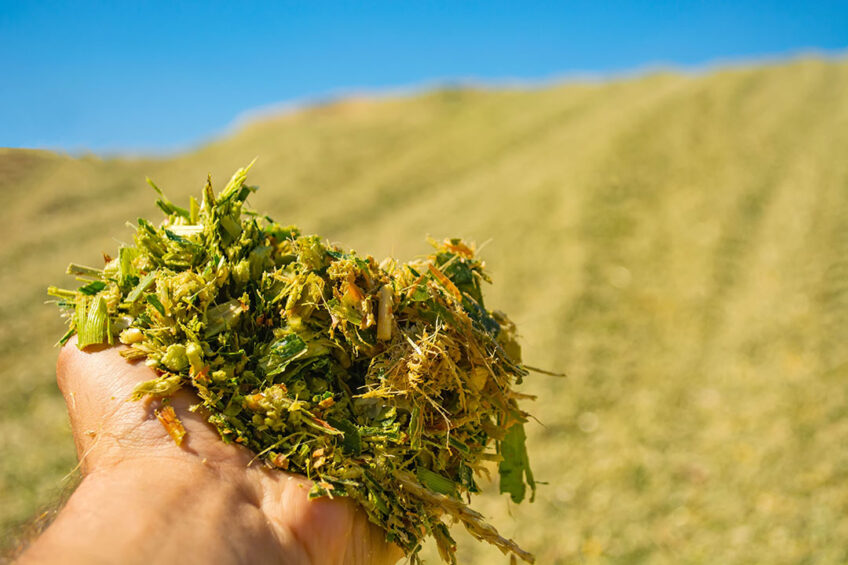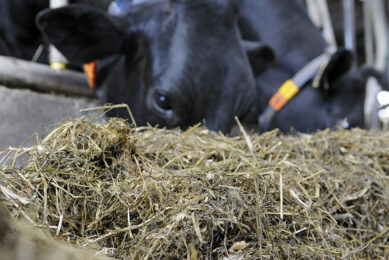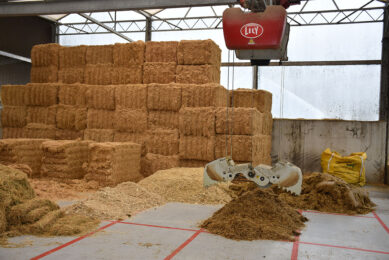Aerobic deterioration of silage

Air is the most important factor affecting silage fermentation. It exerts its influence through the activities of aerobic micro-organisms such as bacteria, yeast and aerobic fungi. These micro-organisms act together on lowering the nutritive value of silage by altering its chemical and physical characteristics.
The main bacteria involved in aerobic deterioration are species of homo-fermentative and hetero-fermentative lactic acid bacteria. These are capable of undergoing aerobic fermentation as follows:
 HOMO-FERMENTATIVE BACTERIA:
HOMO-FERMENTATIVE BACTERIA:Glucose (or fructose) <—> O2 lactate + pyruvate + H2O
(The pyruvate is further fermented to formic acid, acetic acid and CO2.)
 HETRO-FERMENTATIVE BACTERIA:
HETRO-FERMENTATIVE BACTERIA:
Glucose (or fructose) <—> O2 lactate + acetate + H2O + CO2
The role of bacteria in aerobic deterioration varies with different crops. For corn silage, for example, they account for 48% of the variation in CO2 and heat production, whereas with other silages such as grass silage they account for only 8% of these variations.
In addition to bacteria, some members of the genera yeasts may be involved in the aerobic deterioration process. This includes acid utilisers such as candida and Hansenula polymorpha and sugar utilisers such as Torulopsis glabrata. The effect of yeasts becomes obvious when their population exceeds 105/g fresh crop. However, it was found that aerobic deterioration may also occur when the number is less than 105, suggesting that the population of the yeast is not an important factor.
Filamentous fungi may also play a role in aerobic deterioration, particularly with grass silage.
Aerobic micro-organisms in silage are not invaders
The aerobic micro-organisms are endogenous to silage and are not airborne invaders. This conclusion was reached following the exposure of silages to sterilised air and non-sterilised air. Silages in both treatments underwent aerobic deterioration.
During aerobic deterioration, fermentable sugars, proteins, amino acids, lactic acid and acetic acid are all used by these micro-organisms as an energy source. Assimilation of lactic acid and acetic acid results in an increase in the pH. The rise in pH may also be due to the deamination of amino acids by the micro-organisms, which further contributes to the rise in pH through the release of ammonia. As a result of the increased silage pH, there is often an increase in the temperature of the ensiled mass, particularly with crops ensiled at high dry matter (DM) due to the lack of moisture that can dissipate heat. The increased silage temperature and pH provide favourable conditions for the growth and development of moulds. The formation of complex protein structures (protein denaturation) may also occur under high pH and temperature. As mentioned earlier, there is a continuous uptake of sugars by aerobic micro-organisms. Therefore, there is a depletion of the amount of substrates necessary to sustain the growth and development of lactic acid bacteria. This would shift the fermentation from lactic to butyric, with a resulting bad smell of the silage and low acceptability of it by animals. It is also suggested that the aerobic micro-organisms cause the proliferation of coliforms, yeasts and, in later stages, Clostridia. Clostridia would certainly lead to lowering silage quality due to their effect on amino acid deamination and availability of fermentable sugars.
Loss of nutrients and animal production
Aerobic deterioration during storage is often responsible for the majority of DM loss in the forage material conserved as silage, which may be as high as 30–40%. Even short-term exposure to air results in losses. For example, DM lost from corn silage exposed to air for just 1–2 days was measured to be as high as 6%. Besides the economic losses of nutrients, feeding spoiled silage to ruminants depresses nutrient intake and decreases animal production.
Control measures
Several methods are available for controlling the aerobic deterioration problem.
1. Harvest and wilting
Research on corn silage has shown that the proliferation of yeasts often increases when the crop is harvested from the dough stage onwards. Therefore, there is a greater chance for aerobic deterioration when the crop is cut matured.
Research on grass silage has shown that excessive wilting may encourage aerobic deterioration due to the increased DM and the lack of moisture that can dissipate the heat of the ensiled material. However, this may not be an important factor for other crops. For example, it was found that in many cases crops were harvested at more than 50% DM and did sustain the heat and underwent normal fermentation.
2. Chop length
Fine chopping is generally recommended for crops harvested at more than 30% DM, as it helps proper compaction and exclusion of air from the ensiled mass.
3. Filling the silo
Delayed filling should be avoided as it allows the build-up of aerobic micro-organisms. A study was conducted at Kansas State University, USA, to compare delayed filling versus rapid filling of four different varieties of corn and sorghum. Results have shown that rapid filling was advantageous over the delayed filling in terms of:
- Increased lactate-to-acetate ratio;
- Decreased butyric acid;
- Decreased spoilage; and
- Increased DM recovery.
In terms of animal performance, average daily gain and DM intake were greater for the rapid-filled silage. This effect, however, was more pronounced with corn silage than with sorghum silage.
4. Sealing the silo
Sufficient sealing has similar effects on preventing the build-up of aerobic micro-organisms and ensuring subsequent aerobic stability of silage. However, sealing may not be a practical approach for farm application, as it is difficult to prevent aerobic deterioration since air replaces the silage material that has been removed from the silo.
5. Silo type
Long narrow silos are preferred to the short wide ones, because they allow a rapid rate of feedback. Also, the smooth face of the silo is preferred to the rough one because of the smaller surface area that allows less penetration of air.
6. Use of inoculants
In one study, microbial silage inoculants based on homo- and hetero-fermentative lactic acid bacteria had significant positive effects on corn silage quality in terms of improving aerobic stability and fermentation characteristics (Table 1), with a resulting improvement in silage intake and utilisation.
7. Chemical treatment
The use of volatile fatty acids may be useful in preventing aerobic deterioration due to their antifungal properties. This effect may, however, vary depending on the chain length of the acids. Thus, propionic acid is more effective than acetic acid in terms of preventing aerobic deterioration. Research in this area has shown that the addition of 1.25% of propionic acid (on a DM basis) prevented aerobic deterioration of silage.
References are available from the author upon request.











